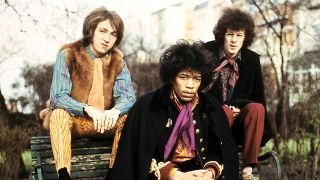The Jimi Hendrix Experience - Are You Experienced (1967)
The album that put the soul in rock’n’roll (and redefined the electric guitar while it was at it)
When Jimi Hendrix landed on British soil and formed the Jimi Hendrix Experience in 1966 he may as well have been beamed down directly from a spaceship en route to Mars. Instead he had been coaxed over from his life as a struggling New York backing musician by former Animals bassist Chas Chandler. And Jimi’s guitar-playing skills were truly other-worldly. Yes, there were plenty of tasty guitarists around in the mid-60s, but no one could hold a candle to Hendrix. On his debut album Are You Experienced in 1967 we were given so many ground-breaking gifts.
What Hendrix managed to do with his guitar, the sounds he occasionally teased, often thrashed out of that lump of wood with strings attached, put him in a league of his own. From screeching feedback to delicious dollops of wah-wah, his tone was an absolute bolt from the blue. Then there were his solos. A guitar solo was no longer a means of getting from the bridge to the final chorus, instead Hendrix’s solos were moments full of colour. When he was in the mood it sounded like his fingers were about to burst into flames.
But Are You Experienced isn’t a guitar-chops wankathon, it’s packed full of killer songs. Not just great songs, but daringly innovative material. There’s the guitar attack of Foxy Lady, Fire with its bonkers, off-the-wall funk feel, and, on the original US release, stripped-back ballads such as The Wind Cries Mary. This record showed Hendrix as a thoughtful, soulful songwriter as well as a smokin’ riff master.
Of course, it wasn’t a one-man show; Noel Redding’s bass lines were the catalyst for a huge bulk of the Experience’s tunes, and the album benefits greatly from the amazing jazz feel of drummer Mitch Mitchell, an imperious player who took centre stage on Fire. Then there was the three-four rhythm which carried Manic Depression. Granted, Neil Peart and Mike Portnoy gobble up such meters for breakfast, but odd time wasn’t exactly commonplace in mid-60s rock, so again another point for the Jimi Hendrix Experience musical trailblazers tally.
Chat with any guitarist of the past 40 years or so and if they don’t acknowledge Are You Experienced as an influence then they bloody well should do – just ask Beck, Clapton et al. It’s a record that changed our musical landscape in so many ways it made your head spin. It gave a glimpse of just what could be achieved with a guitar. The reverberations from Jimi’s experiments across its tracks can certainly still be felt today. It also brought a treasure trove of genres together, from rock and soul to psychedelic funk and even folk. In doing so it proved that sometimes if you take some risks with music you will be richly rewarded.
And then there’s Hendrix himself. Are You Experienced put this Seattle kid on the map as the greatest guitarist of his time, and one of the most iconic rock stars the world had ever seen, both of which still ring true today. If that’s not a legacy, we don’t know what is.
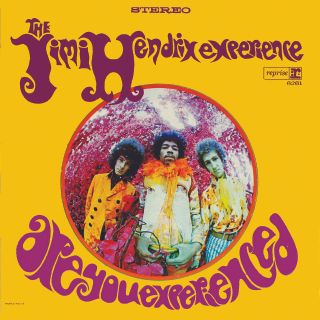
The Byrds - Sweetheart Of The Rodeo (1968)
The album that took rock to the country
The Byrds morphed from folk-rockers to raga-rock pioneers to psychedelic voyagers within the space of three years. But 1968’s wholesale immersion in country music was just too much for many fans, who swiftly turned their backs on the band. Sweetheart Of The Rodeo nevertheless ushered in the country-rock explosion of the 70s and the subsequent Americana movement.
Tyrannosaurus Rex - My People Were Fair And Had Sky In Their Hair… But Now They’re Content To Wear Stars On Their Brows (1968)
The album that kick-started the eight-track revolution
Young American producer Tony Visconti was “holding out for something really different and unusual” when he chanced upon Marc Bolan’s Tyrannosaurus Rex at the UFO club in London. My People Were Fair – which forewent electric rock for ringing percussive folk versed on acoustic guitars, pixiphones and a Chinese gong – was made with Advision Studios’ pioneering eight-track technology, predating its use by The Beatles. Within a year, Visconti was also producing another new charge: David Bowie.
Blue Cheer - Vincebus Eruptum (1968)
The album that invented heavy metal
It’s January 16, 1968, and the births of Led Zeppelin and Black Sabbath are still months away. And a US power-trio by the name of Blue Cheer are about to gazump both of these now better-known bands by releasing an album of thunderous, electrified blues. That record was Vincebus Eruptum, and its emergence signifies the start of a brand new, animalistic phenomenon that is now referred to as heavy metal.
Funkadelic - Maggot Brain (1971)
The album that gave rock that funky feeling
Funk rock in recent years may have been watered down to one part groove, three parts mainstream pap, but the record that helped give birth to the genre remains as vital now as the day it was released 45 years ago. Maggot Brain mixed funk grooves, soul heart and acid-trip psychedelia in a way that had never been heard before. Or since, for that matter
King Crimson - In The Court Of The Crimson King (1969)
The album that put prog on the map
Prog rock’s first truly decisive statement was rich, ambitious, lyrically pointed and musically complex, drawing its inspiration from European classicism rather than from the traditional outlet of American blues and rock’n’roll. Island Records’ decision to let King Crimson produce themselves let the band overdub layers of symphonic detail, with multi-instrumentalist Ian McDonald making full use of a Mellotron and guitarist Robert Fripp uncorking an astonishing extended atonal solo on the monumental 21st Century Schizoid Man.
Bob Dylan - Bringing It All Back Home (1965)
The album that defined rock
As landmark recordings go, there are none more game-changing than Bringing It All Back Home. The A-side of Dylan’s fifth album was his first with an electric band, the B-side (while more familiarly acoustic and drum-free) exchanged folky protest for lyrics that were more personal, poetic and profound. The grit remained, but there was a degree of self-analysis and abstraction that captured the prevailing mood of a rapidly changing zeitgeist.
Opening track Subterranean Homesick Blues – still one of the greatest popular songs of any given genre – provided Dylan with his first US hit, while the six-and-a-half-minute Bob Dylan’s 115th Dream expanded the parameters of what pop could be (opening the eyes, ears and imaginations of attentive acolytes Lennon, McCartney, Jagger, Richards, Davies, Townshend, Reed, Bowie et al). In support were Maggie’s Farm, It’s Alright, Ma (I’m Only Bleeding), It’s All Over Now, Baby Blue and Mr Tambourine Man. All classics, and all – on their contemporaneous arrival with The Beatles’ Ticket To Ride – astounding. Two months later the Rolling Stones were inspired to make the quantum leap from The Last Time to (I Can’t Get No) Satisfaction.
Bringing It All Back Home broadened pop’s vision, and in so doing defined rock. Dylan’s quirky and unusual (decidedly non-pop) voice sneered revolution with every syllable, his message was literate, but street-smart, and owed more to dustbowl country and urban blues than to Tin Pan Alley schmaltz or, for that matter, processed Motown slickness. In 1965 you didn’t need a weatherman to know which way the wind blew, you only needed Bob.
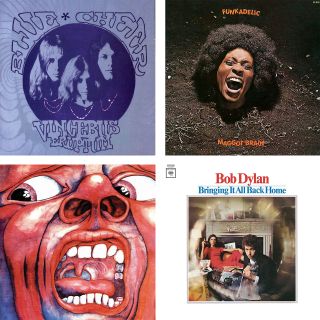
Mike Oldfield - Tubular Bells (1973)
The album that built an empire
Mike Oldfield was only 19 when he recorded the multi-layered Tubular Bells, which set a new benchmark for instrumental prog and redefined the notion of a one-man band. It was also a massive commercial hit, boosted by the appropriation of its eerie piano motif for the film The Exorcist. Tubular Bells had already been rejected by a host of labels before Richard Branson made it the first release for his new label Virgin Records. The album clung to the charts for five years and eventually sold 17 million copies.
Talking Heads - Talking Heads: 77 (1977)
The album that made art-rock a thing
The Ramones were bubblegum punk, Blondie were pop and Television roamed wild over jazz scales. If any of New York’s class of ‘77 could lay claim to popularising art-rock, then it was Talking Heads, fronted by a man whose fidgety yelp and allusive lyricism mirrored the band’s terse rhythms, abrupt tempo changes and primitive grooves. The Heads’ debut became the lodestone for a new kind of indie sensibility. RH
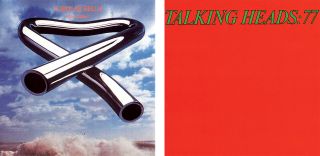
Damned - Damned Damned Damned (1977)
The album that defined UK punk
While not the first punk album per se – that (in)distinct honour will be scrapped over forever by champions of the Ramones’ debut and countless other primitive sonic spitballs – on its release on Stiff Records in February ’77, Damned Damned Damned fired the opening fusillade in UK punk’s brutal assault on prevailing rock complacency.
In order to get the jump on scene leaders the Sex Pistols, whose tabloid notoriety and successive sackings conspired to hold up the arrival of their Never Mind The Bollocks until late October, the Damned recorded the album’s dozen tracks in just 10 frantic days with producer Nick Lowe in claustrophobic conditions at North London’s shoebox-sized Pathway Studios.
Written mostly by guitarist Brian James, Damned Damned Damned defined the shock of the new while fully acknowledging its past. Climaxing with an appropriately loutish bludgeon through the Stooges’ I Feel Alright (aka 1970) it sent countless nascent garage bands straight to Detroit visionary Iggy Pop’s hitherto overlooked catalogue for inspiration. While utilising a similar blend of Dolls, Stooges, MC5 and ragamuffin mod to the Pistols, the Damned were faster, more frantic; there was less sociopolitical menace, Chelsea clobber and situationism, more full-tilt mayhem, plastic sunglasses and custard-pie fights.
Damned Damned Damned was immediately embraced as the essential punk-rock artefact, each component track was studied, absorbed, its vinyl worn out, by a generation of year-zero punks with literally nothing else to play. Neat Neat Neat, New Rose, Stab Yor Back; their influence endures.
Damned Damned Damned wasn’t just the first UK punk album, it was also arguably the best.
Peter Gabriel - Peter Gabriel (1982)
The album that found fame for the fairlight
“I’d been dreaming for some time of an instrument that could sample stuff from the real world and then make it available on a keyboard,” recalled Peter Gabriel, who became one of the first recipients of a Fairlight CMI, a new digital sampling synth from Australia, at the turn of the 80s. “I spent a lot of time then collecting sounds; going to factories, to the university and getting interesting samples which were then used on that record… It was really one of the key things that gave that record a different sound.”
The album in question was Peter Gabriel, aka Security, released in September 1982. Kate Bush, Stevie Wonder and Jean Michael Jarre had already started to make use of the same technology, but Gabriel was the first to fully incorporate the Fairlight on a populist rock album. And, thanks to a South Bank Show special detailing the inception of the album, he became its most high-profile advocate.
Gabriel’s imaginative use of texture became a key feature of the album, blending world rhythms and exotica with sequenced percussion and sampled loops. This was stunningly well-realised on Rhythm Of The Heat which addressed Carl Jung’s disorienting experience with native drummers in Africa. Gabriel’s aim was to convey “a really important Western mind losing himself in something more primitive and more instinctive… And in the music we tried to do that as well.”
By the end of the 80s, digital sampling had become an essential tool and commonplace within the music industry.
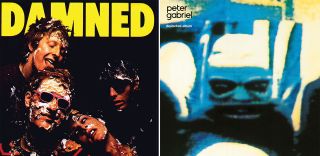
Stevie Ray Vaughan - Texas Flood (1983)
The album that brought the blues back into focus
The blues was washed-up by the early 80s, a once-proud genre hanging on to relevance by a thread. But with gems like Pride And Joy and Love Struck Baby on this debut the Texan applied the defibrillator, reinstating the blues to a status it hadn’t enjoyed since the 60s boom and ensuring its voice was heard through the decade to come.
Violent Femmes - Violent Femmes (1983)
The album that introduced us to nerd-rock
Three dorkadelic misfits from the American farm belt, playing ratty rock‘n’roll on acoustic instruments, wasn’t the most bankable proposition in the early 80s, an era dominated by electro-pop and hair-metal. Yet the Violent Femmes heralded the birth of the anti-cool, with singer-songwriter Gordon Gano’s literate hymns to self-loathing, despair and sexual frustration staking a rightful claim for the geeks to finally inherit the earth. A massive influence on the Pixies and, by extension, the grunge generation.
Diamond Head - Lightning To The Nations 1980
The album that was a benchmark for NWOBHM
The New Wave Of British Heavy Metal was, by its very nature, an independently based movement. From all four corners of the UK it saw bands united in a determination to play a style of music that was considered redundant and unfashionable. With record label interest at an all-time low, this usually meant going down the self-financed route. The members of Iron Maiden pooled forces to raise £200 to make their debut EP, The Soundhouse Tapes, and when Def Leppard came to recording their own introductory statement, The Def Leppard EP, they borrowed £148.50 from singer Joe Elliott’s father. In return for such initiative, both acts were rewarded with major-label record deals (though, of course, Elliott still distances Leppard from the NWOBHM). Cue world tours, gold and platinum discs, luxurious tour buses and the same trappings as the rock stars they had idolised.
For Diamond Head such corporate intervention came to exert quite the opposite effect. In many ways the signing of a major-label deal would spell their very undoing.
Although the Midlanders had released two extremely well-received singles – Shoot Out The Lights and Sweet And Innocent – on local independent labels, London-based talent scouts still failed to spot the quartet’s glaring potential.
The genre’s pace-setters had swiftly been scooped up by the management elite in the case of Leppard, who joined the stable of Peter Mensch and Cliff Burnstein’s Q Prime; in Maiden’s case, what Rod Smallwood may have lacked in major-league experience was compensated for with raw guile and sheer determination.
In sharp contrast, Diamond Head were advised by a partnership of Linda Harris, mother of lead singer Sean, and local businessman Reg Fellows who’d made his money through the manufacture of cardboard boxes. The album now known either as Lightning To The Nations or the White Album (its plain sleeve didn’t reveal band name, title, track listing or the identities of the musicians) hadn’t even been intended as an official debut. Instead the group had spent seven days laying down the cream of their live repertoire, pressing up 1,000 copies of what they called a ‘white-label promo’ purely as a tool for further interest. Indeed it was packaged so anonymously because – wait for it – Fellows had a job lot of card going spare.
The music, however, was staggering. Brian Tatler was a master riffer in the Tony Iommi mould, never adhering to a single idea in a song, while Harris’s voice, although slightly unusual, brimmed with character and power. The album’s energy and depth of songs would influence an entire generation of hard rock bands, notably Metallica and Megadeth.
Lightning wasn’t the first NWOBHM album ever recorded, but it may well be the most important of them all. And yet signing to MCA, who idiotically prioritised the singles market over albums, would impact fatally upon a variety of other issues that bubbled beneath the surface.
Today Tatler continues to drive Diamond Head onwards and a new, self-titled album taps back into the spirit of a debut that still resonates.

Linkin Park - Hybrid Theory (2000)
The album that brought nu-metal to the pop kids
It’s easy to sneer retrospectively at the nu metal movement. But when Linkin Park arrived with Hybrid Theory, the genre’s greatest exponents had all the thrilling momentum of the sleeve art’s charging soldier.
Piling elements of nosebleed metal, bullet-belt rap and electronica into the blender, the album seemed bound for the bedrooms of grounded teenagers. All credit, then, to Don Gilmore’s production, which dug out the latent pop sensibilities and pushed Hybrid Theory into wider contention.
It’s worth reminding yourself just how big it was. Five smash-hit singles. The biggest-selling US album of 2001. The second-biggest internationally. The album also hammered home the shifting attitudes of metal musicians – Brad Delson telling Total Guitar that guitar solos were “hogwash” – and ensured a leaner sound in post-millennium rock, for better or worse.
The White Stripes - Elephant (2003)
The album that defined rock for the new millennium
While the Class Of 2003 nipped, tucked and Pro Tooled their albums to a hairless sheen, a footnote in the Elephant sleevenotes read: “No computers were used during the writing, recording, mixing or mastering of this record, and none of the recording equipment was more recent than 1963”.
If the Detroit duo’s attitude seemed hopelessly anachronistic in the age of the iPod, then it was vindicated by their fourth album’s blanket success. Critically acclaimed, Elephant also scored the Stripes their first UK#1, gave the rock scene the poster-boy it desperately needed (Jack White), and returned rock‘n’roll to first principles after the drop-tuned detour of
nu metal. The primal ferocity of cuts like Ball And Biscuit and
the route-one idiot-chant of Seven Nation Army reminded us that the best music was torn, frayed, greasy, imperfect.
Elephant was an album that signposted rock’s future by embracing its past. And unlike many buffed and quantised records from the period, it still sounds timeless.
Metallica - Master Of Puppets (1986)
The album that brought thrash to the masses
Although it was the last thing on the minds of the group that made it, and the full ramifications would not be immediately apparent, Master Of Puppets was the game-changing album that transformed thrash-metal into something that bordered upon – gasp! – an acceptable form of music.
In the wake of the Californians’ second set, Ride The Lightning, MOP continued to escalate the introduction of light and shade to Metallica’s sound, a consideration all but overlooked on a blitzkrieg debut, Kill ’Em All. During the interim, drummer Lars Ulrich and guitarist Kirk Hammett took some tuition (the latter from Joe Satriani), while rhythm guitarist/frontman James Hetfield began adding smart themes to his lyrics in earnest, including the tapping of HP Lovecraft for The Thing That Should Not Be.
In America the band had moved onto a major label with Ride The Lightning and though Metallica still refused to make promo videos – something they wouldn’t back down on until things really changed with their next album, …And Justice For All – the process of evolution displayed on Master… was unmistakable.
Whereas on Ride The Lightning Metallica had acquiesced to Elektra via the inclusion of an overtly commercial track, Escape, Master… saw the self-sufficient ticking of all necessary boxes – improved song structure and musical competence, continued intensity levels and, crucially, more finely integrated commerciality.
In short, Master Of Puppets was the album that persuaded many people outside of a core fan-base to cautiously remove their blinkers and actually listen.

Pixies - Doolittle (1989)
The album that broke alt.rock
Pixies screamer-in-chief Black Francis once recalled lying on the living room floor of guitarist Joey Santiago while the Doolittle demo played, sensing that his band were about to cause a tectonic shift. “I remember going, ‘Wow, we really did something special’. And we hadn’t even made the record yet.”
His instinct was on the money. The received wisdom, as trotted out by revisionists, is that Nirvana fired the starting pistol with 1991’s Nevermind, mobilising the alt.rock hordes to pour over the battlements and slit the throat of hair-metal. In truth, Pixies got there two years earlier – before Bleach, even – with a second album that combined bristling fury with the hooks to take it overground.
Leftfield hit singles like Monkey Gone To Heaven and Here Comes Your Man were a razor across the eyeball of the rock scene, establishing that nowhere-town misfits could hijack the bloated gloss of MTV.
But perhaps Doolittle’s defining contribution was the schizophrenic quiet/loud gearshift that would soon be common currency in the 90s rock soundscape. “Pure dynamics,” reflected David Bowie of those sonic sucker punches. “Very obvious now, but not obvious at the time. A dynamic of keeping the verse extremely quiet and then erupting into a blaze of noise.”
Even Kurt Cobain would openly admit that Smells Like Teen Spirit was his attempt to “basically rip off the Pixies”: a tip of the hat that Francis was happy to accept in 2013. “If Kurt Cobain ’fessed up to it, then fuck it, I’ll agree with it – you ripped us off…!”
Guns N’ Roses - Appetite For Destruction (1987)
The album that returned rock to the radio
Though it couldn’t possibly have been made by a more self-destructive, sleazy set of scumbags, Appetite… was the album that put stadium rock back on the radio. It was bold, it was catchy and dangerous but even the band and their organisation had no inkling it would sell beyond a hundred thousand copies, in fact there was a time when such goals seemed laughable. But once momentum took hold, GN’R and the circus surrounding them became unstoppable.
Marillion - Anoraknophobia 2001
The album that got the fans to pay upfront
It still wasn’t called ‘crowdfunding’ as we know it today, but Marillion were extremely proud of their role in the development of something that has now become commonplace in the music industry. Following
a run of independently released albums that, according to singer Steve Hogarth, had all managed to sell “between 70,000 and 80,000 copies”, Marillion cut a ground-breaking deal with EMI, the group’s first record company, that allowed 12,000 of their fans to pre-order (and pay for) their next record, Anoraknophobia, 12 months in advance. The idea had been conceived four years earlier when a group of fans raised $60,000 to pay for an otherwise unaffordable tour of the USA.
“The internet saved our bacon,” Hogarth admitted to Classic Rock. “It gave us a medium through which to collect data, identify our fans and advertise to them directly without spending any money. We’ve got Mark Kelly [keyboards] to thank for that, because he saw its potential in the very early days.”
The arrangement allowed Marillion access to the clout of EMI while the label lapped up guaranteed sales – a win-win situation.
“We were unsure whether somebody like EMI would be interested [in the idea] but we came into their building and presented to them and at the end of the meeting they practically broke into applause,” Hogarth said. “Basically, we were offering them free money. If we can sell 10,000 copies of this record, they can do 90,000 through the shops. All we wanted was a decent royalty rate and a reasonable marketing campaign.”

Tape decks, drugs and Abbey Road: how The Beatles’ Revolver revolutionised rock
